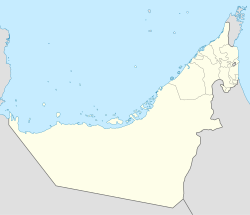Wadi Ejili | |
|---|---|
| Coordinates: 25°02′08″N56°09′08.3″E / 25.03556°N 56.152306°E | |
| Country | United Arab Emirates |
| Emirate | Ras Al Khaimah |
| Elevation | 421 m (1,384 ft) |
Wadi Ejili is a wadi, or seasonal watercourse, in the Hajar Mountains of Ras Al Khaimah, United Arab Emirates. It runs down from the confluence of the Wadi Shawka and Wadi Esfai to run into the Wadi Helo at the village of Fayyad, on the Sharjah-Kalba Highway (E102).






